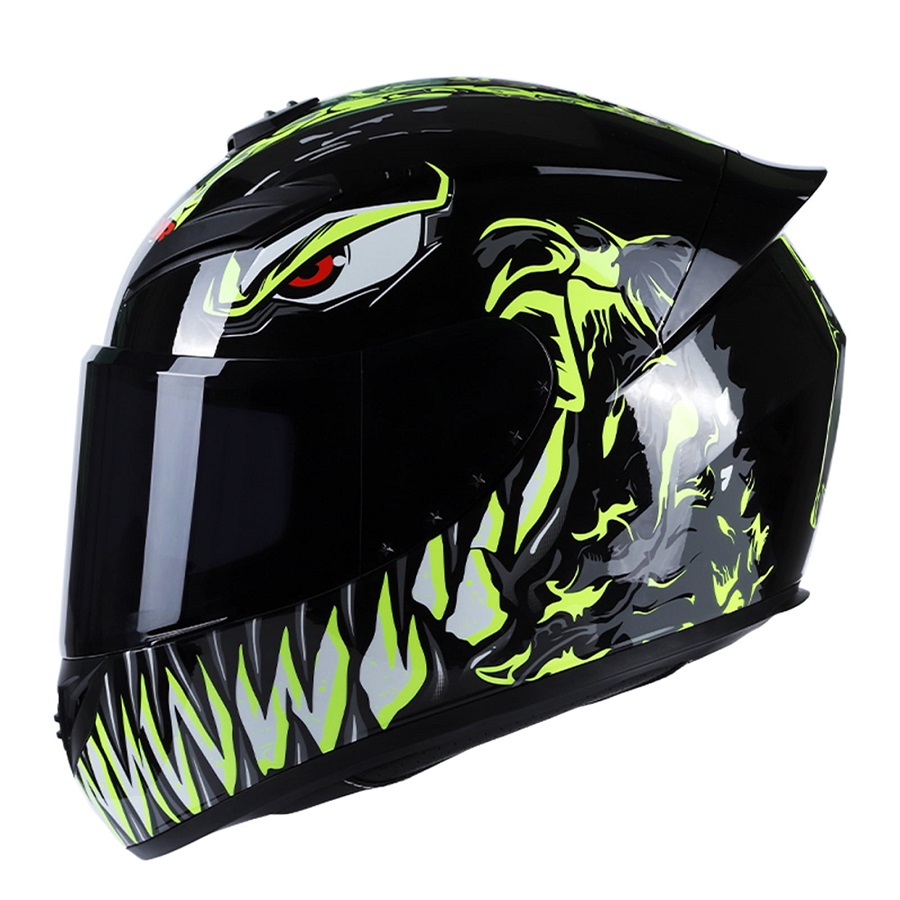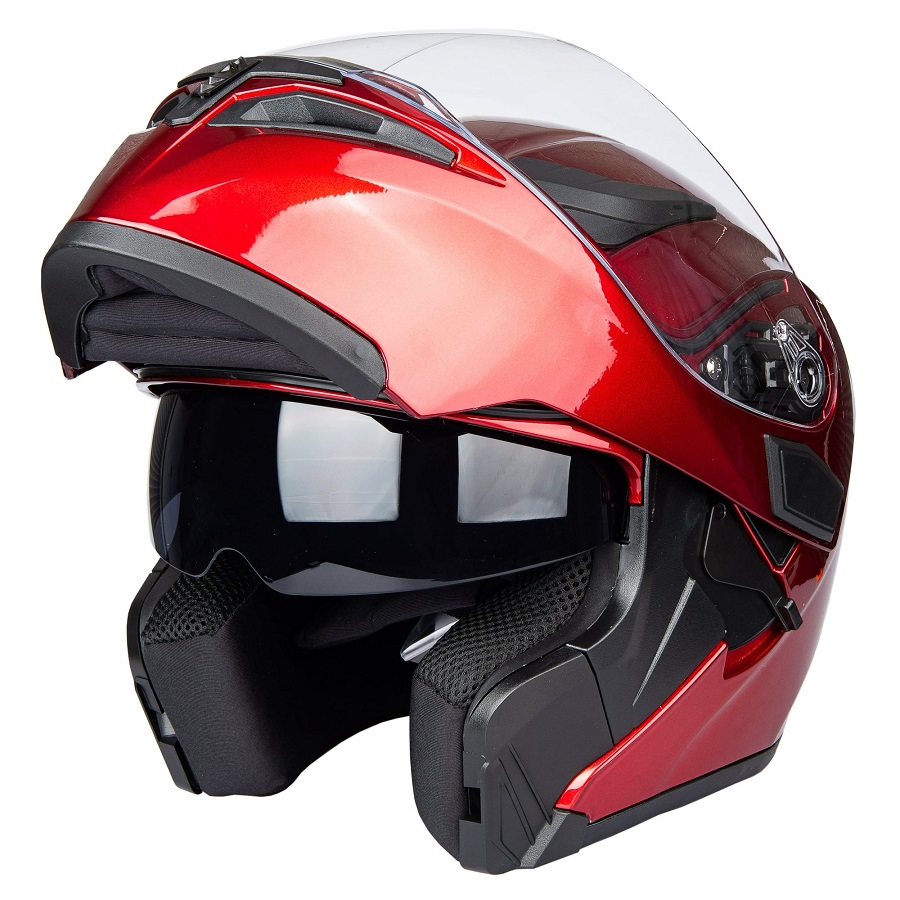Introduction
Motorcycle riding is not just a mode of transport; it’s an exhilarating lifestyle that attracts millions of enthusiasts around the world. However, with liberty comes responsibility, and protecting oneself on the road is paramount. Full-face motorcycle helmets are one of the best safety measures you can take to shield yourself while riding, providing comprehensive protection for both the head and face. This guide aims to give you an in-depth understanding of full-face motorcycle helmets, including their safety standards, styles, features, and how to choose the right one for your riding needs.
What is a Full-Face Motorcycle Helmet?
A full-face motorcycle helmet encapsulates the entire head, providing coverage for the forehead, face, and chin. Unlike open-face or modular helmets, a full-face helmet offers a solid structure with a fixed chin bar and a full visor, which protects the rider’s face from wind, debris, and inclement weather conditions. Due to these features, full-face helmets are considered one of the safest options available.
Safety Standards
When it comes to safety, not all helmets are created equal. Understanding the safety standards can help you make an informed decision:
DOT (Department of Transportation)
In the United States, the DOT certification is the minimum requirement for motorcycle helmets. A DOT-approved helmet has passed rigorous impact and penetration tests and provides adequate retention performance to ensure it will stay firmly on your head in the event of an accident.
ECE (Economic Commission for Europe)
ECE certification is widely recognized across Europe and is considered more stringent than DOT standards. Helmets approved by the ECE must pass multiple tests, including impact absorption, chin strap strength, and peripheral vision requirements.
Snell
The Snell Memorial Foundation offers a more demanding certification that addresses aspects ignored by DOT and ECE. A Snell-approved helmet undergoes more rigorous testing for impact, penetration, and retention, making it one of the highest standards for motorcycle helmet safety.
Other Safety Ratings
Some manufacturers design helmets beyond standard certifications. Always check the helmet for the required safety certification stickers, as these indicate the level of protection the helmet provides.
Key Features of Full-Face Helmets
Shell Material
The outer shell of full-face helmets is typically constructed from materials like polycarbonate, fiberglass, or carbon fiber. Polycarbonate is the most affordable and relatively lightweight but may offer less durability. Fiberglass shells are stronger and provide better impact resistance, while carbon fiber is the lightest and most advanced option, boasting high strength-to-weight ratios.
EPS Liner
The expanded polystyrene (EPS) liner is the interior padding designed to absorb impact energy during a crash. Helmets with multi-density EPS liners provide additional protection by managing impact forces better than single-density liners.
Ventilation
Proper ventilation is crucial for comfort. Full-face helmets often feature vents at the chin, brow, and rear. Some advanced models include adjustable vents and removable liners, allowing you to customize airflow based on weather conditions.
Visor System
Full-face helmets typically come equipped with a clear, tinted, or mirrored visor that helps to protect your eyes from wind, debris, and UV rays. Look for helmets with anti-fogging and anti-scratch coatings for enhanced visibility. Many full-face helmets also offer Pinlock-ready visors for superior anti-fogging performance.
Communication Systems
Integrated Bluetooth communication systems are becoming increasingly popular, allowing riders to connect with their smartphones, GPS devices, or fellow riders. Some helmets are designed to accommodate these systems seamlessly for a more enhanced riding experience.
Weight and Fit
A helmet’s weight can significantly affect the comfort, especially during long rides. A well-fitted helmet should feel snug but not too tight, distributing its weight evenly across your head. Always try on various models to find the right fit that does not compromise safety.
Styles of Full-Face Helmets
Sport/Touring Helmets
Sport and touring helmets are designed for high-speed riding and long-distance travel. These helmets prioritize aerodynamics and comfort, often featuring a more streamlined shape, advanced ventilation systems, and sound-dampening properties.
Adventure/Off-Road Helmets
Adventure helmets typically feature a longer peak visor for off-road riding. They balance comfort for both on-road and off-road riding, offering excellent ventilation and compatibility with goggles.
Track Helmets
Designed specifically for racing, track helmets often have a tight fit, reduced weight, and superior aerodynamic designs. They might come with features such as quick-release straps and emergency cheek pad removal systems.
Cruiser Helmets
Generally more inspired by retro designs, cruiser helmets focus on comfort and style over aerodynamics. They may incorporate leather finishes and customizable options while still meeting safety requirements.
How to Choose the Right Full-Face Helmet
- Determine Your Purpose: Are you riding long distances, going off-road, or primarily for sport? Your riding style will dictate the type of full-face helmet that suits you best.
- Budget: Helmets can vary widely in price. While it’s tempting to go for the cheapest option, prioritizing safety is essential. Aim for helmets certified to recognized safety standards within your budget.
- Fit and Comfort: Always try on a helmet before purchasing. Look for a proper fit where the helmet remains snug on your head without causing pressure points. Wear it for a few minutes in the store to assess comfort levels.
- Weight: Choose a helmet that is lightweight and comfortable, especially for long rides. The weight can vary between different materials, so consider this in your choice.
- Ventilation and Noise: If you’ll be riding long distances, consider helmets with good ventilation and lower noise levels for a more enjoyable experience.
- Additional Features: Look for extra features like interchangeable visors, communications compatibility, and pinlock systems to enhance the overall experience.
Maintenance and Care
Proper care and maintenance can extend the life of your helmet. Here are some tips:
- Clean the Exterior: Use mild soap and water to clean the helmet’s shell. Avoid using harsh chemicals that can damage the finish.
- Check the Liner: Remove the interior padding if possible and wash it periodically according to the manufacturer’s instructions.
- Inspect Regularly: Regularly check for signs of damage, such as cracks or the ingress of contaminants.
- Store Properly: Keep your helmet in a cool and dry place, away from direct sunlight and severe temperatures.
- Replace as Needed: Helmets have a lifespan of about 3-5 years, or sooner if involved in an accident. Always replace a damaged helmet for optimal safety.

Understanding Full-Face Helmets
Full-face helmets are designed to cover the entire head, face, and neck area, providing a higher level of protection compared to other helmet styles, such as open-face or half helmets. They feature a rigid outer shell, an inner impact-absorbing layer, and a full face shield that protects the eyes and face from debris, wind, and weather conditions.
Types of Motorcycle Helmets
- Full-Face Helmets: These cover the entire head and provide maximum protection.
- Modular Helmets: These combine features of full-face and open-face helmets, allowing the front to be lifted for convenience.
- Open-Face Helmets: These protect the top and back of the rider’s head but leave the face exposed.
- Half Helmets: These cover only the top of the head, providing minimal protection.
The Safety Advantages of Full-Face Helmets
1. Maximum Protection
The most compelling reason to opt for a full-face helmet is the superior level of protection it offers. According to statistics from the National Highway Traffic Safety Administration (NHTSA), helmets are 37% effective in preventing fatal injuries to motorcycle riders. Full-face helmets protect the vulnerable areas of the face and skull, including the chin, jaw, and forehead, which are particularly susceptible to injury in the event of a crash.
2. Reduced Risk of Facial Injuries
Facial injuries, including fractures and lacerations, are unfortunately common in motorcycle accidents. Full-face helmets significantly reduce the likelihood of such injuries by covering the entire facial area. This is crucial because face injuries can lead to long-term consequences, both physically and psychologically.
3. Enhanced Aerodynamic Performance
Full-face helmets are designed with aerodynamics in mind. The streamlined shape reduces drag and wind resistance, allowing for a smoother ride at higher speeds. This aerodynamic benefit can enhance a rider’s overall experience and contribute to better handling of the motorcycle.
4. Improved Visibility and Protection from Elements
Many full-face helmets come equipped with a face shield that protects against wind, rain, dust, and debris. Clear visors can provide excellent visibility while tinted or polarized options can reduce glare on sunny days. Moreover, full-face helmets often include anti-fog coatings, ensuring that your line of sight remains unobstructed in a variety of weather conditions.
5. Noise Reduction
With the full coverage provided by a full-face design, riders often experience a significant reduction in wind noise compared to open-face or half helmets. This noise reduction can enhance communication while riding and decrease fatigue during long journeys.
Comfort and Convenience Features
1. Ventilation Systems
Modern full-face helmets are equipped with advanced ventilation systems to enhance airflow and keep the rider cool. Well-placed vents and liners can help regulate temperature, improve comfort, and minimize sweat accumulation during rides.
2. Padding and Fit
The inner lining of full-face helmets is typically padded and designed for comfort. A proper fit is crucial; many helmets come with adjustable padding to ensure a snug yet comfortable feel. A well-fitted helmet reduces the risk of distraction while riding and ensures that the helmet remains securely in place in the event of an accident.
3. Bluetooth and Tech Features
Many full-face helmets on the market today come with built-in Bluetooth systems, enabling riders to communicate, listen to music, or use navigation devices without compromising safety. This technological integration provides an added layer of convenience for modern riders.
Legality and Insurance Benefits
In many regions, the use of helmets is mandated by law, with full-face helmets often considered the standard for compliance. Riding without a helmet can result in citations, fines, and in some cases, increased insurance premiums. Moreover, in the event of an accident, wearing a full-face helmet can positively influence insurance claims and liability considerations.

Conclusion
Full-face motorcycle helmets are critical for ensuring the safety and comfort of riders across various types of motorcycles. By understanding the different styles, safety standards, and essential features, you can choose a helmet that fits your riding style and provides the protection you need. So, whether you’re a seasoned pro or new to the world of motorcycle riding, investing in a quality full-face helmet is a decision that could make all the difference in your riding experience. Always prioritize safety, stay informed, and enjoy the ride!

Leave a Reply